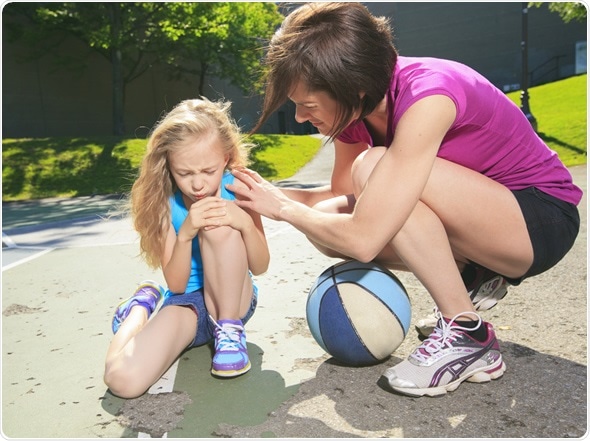Adolescents are fairly active on the sports field. They play contact sports like football, basketball, and hockey. They practise with their teams regularly and are quite likely to end up with minor scrapes and bruises as they pursue their passion. Even non-contact sports such as softball, baseball, track and field can cause physical injuries.
Most of these sports injuries can be handled with appropriate first aid treatment. Sometimes children may end up with a more serious sports injury that requires medical intervention. Yes, Little Leaguer’s shoulder or elbow are actual medical stress injuries that young children suffer from. It is best not to risk the health of the child and get a medical opinion.

Image Copyright: Lopolo / Shutterstock
Common Causes of Sports Injuries in Children
Physical injuries can affect the tendons, ligaments, bones, muscles, and more. Pain and swellings can be caused due to injuries to the knees, shoulders, elbow, back, and heel. Pain is not a natural state of being. Any lasting pain should be referred to a medical professional so as to get timely treatment. About 95% of teenagers in the United Kingdom take part in organized sports in schools and 11% of them are injured each academic session.
Overuse: This in an injury that causes traumatic damage to a bone, muscle, or tendon due to the repeated use of the area without allowing enough time for the natural restorative processes of the body to occur. It is characterized with pain either during the activity time, or immediately afterwards. There may be unremitting pain long after the activity is over.
Over Training: Athletic training needs to be carefully monitored and supervised as it can easily become too much for the adolescents. A good training regimen will include repetitions, but they should not be the cause of bodily harm. The coaches have to take care to fine the correct balance between training and overdoing it when making the children practice.
Burnout: Burnout has been defined as “series of psychological, physiologic, and hormonal changes that result in decreased sports performance.” Children with burnout may deal with fatigue, lack of enthusiasm about practice, and difficulty in completing the regular routine associated with their sports training. It can be a side effect of over training.
Common Sports Injuries in Children
Tendon or Muscle Injuries: Also called a strain, the injury can affect the entire muscular organ including the nerves that contract and produce movement. The tendon is the tough tissue cord connecting the muscle to the bone. Straining the tendons can be a common sports injury.
Ligament Injuries: The ligament is the set of fibrous tissue which connects two or more bones at a joint. When the ligament is injured it is referred to as a sprain. An ankle sprain is perhaps the most common sports injury that children suffer from.
Injuries of the Bone Growth Plate: The Bone Growth Plate refers to the developing tissue at the end of long bones in children and adolescents. This solidifies into solid bone once the child has reached maximum growth. An injury to this region can affect the normal development of the bone.
Fractures and Dislocations: Breaking of bones and dislocation of ball and socket joints such as those present at the shoulder are major traumas. They will be extremely painful and need immediate medical attention.
Dehydration and Exhaustion: If the environment is hot and the children are not drinking adequate amounts of fluid, dehydration is a real possibility. This could lead to heat stroke which includes headaches, dizziness, disorientation, and even fainting spells.
Treatment of Sports Injuries in Children
Immediate treatment of a sports injury can make it easier for the child to recover. For soft tissue or bone-related injuries, first aid treatment is often encapsulated by the acronym RICE, which stands for Rest, Ice, Compression, and Elevation. The idea is to get the adolescent as comfortable as possible and then get professional medical assistance.
The actual treatment prescribed will vary based on the injury. Obvious fractures and dislocation will require immediate medical attention. Prolonged swelling or acute pain should also be considered critical. Should either persist, the child should be accompanied to a medical professional right away. Even if the injury is not too severe, it is a good idea to let the doctor have a look at it anyway.
Why is Prevention of Sports Injuries Necessary in Children?
Injuries in children can adversely affect the growth of the bone or soft tissue that is damaged. A sports injury which is ignored in childhood can become the sources of lifelong pain. Plus some injuries may lead to improper growth of bone and soft tissue if not treated in time.
In adolescents, bone biomechanical properties change drastically during growth spurts. Bone stiffness due to injury may put the child at risk for fractures at a later stage. While most sports injuries are minor and quickly healed, please do not ignore pain or swelling for the well being of the child.
References
Further Reading